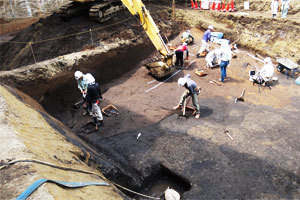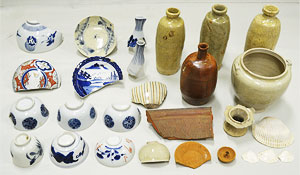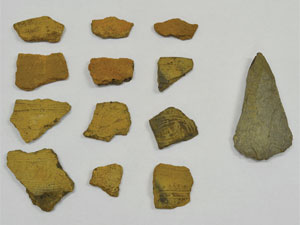Academic Year 2014
Vol.79 Buried Cultural Properties from the Jomon Period to the Modern Period
March 12, 2015
Academic Year 2014From mid-May to late July last year, a survey of buried cultural properties was conducted prior to the start of full-scale construction for the reconstruction of the 55th and 58th Buildings on the Ichigaya Campus. The survey was conducted to record and preserve buried cultural properties in the area surrounded by the Boissonade Tower, the 55th Building, and the Piloti. 480 archaeological sites were found at the survey site, ranging from the Jomon to modern periods, mainly from the Edo period, and about 100 storage boxes of artifacts were excavated.
The Ichigaya Campus is located on an undulating plateau called Yodobashi-dai on the eastern edge of the Musashino Plateau, which stretches between the Arakawa and Tama Rivers. According to an Edo period map, there were 19 Hatamoto residences in the area around the campus, of which the residences at the survey site were rearranged during the Enpo, Hoei, and Kansei periods.

A scene from the survey of buried cultural properties
Excavations were conducted in the early, middle, and late Edo period, and three aspects of daily life were confirmed, including the remains of roads, foundation stones of buildings, ditches, dugouts, and waste pits.
These artifacts are valuable for understanding the lifestyle of Hatamoto who lived in this area, which belonged to the "bancho" district at that time.
In 1636, the outer moat construction, a major project of the Edo period, was undertaken, and during this survey, traces of fill from the sand dug out of the area were confirmed, and in some places the fill was as much as 4 meters high.

A large amount of porcelain such as plates, bowls, and tokkuri (Japanese sake cups) and fish bones from the Hizen, Kishu, Seto, and Mino styles were excavated from the waste pits (trash pits) of the Edo period.
In addition, one Jomon-period living surface was identified beneath the Early Modern and Modern living surfaces. Perhaps because the Jomon Period survey site was on the slope of a tributary valley (valley of a tributary stream) that lowered toward the northeast, no remains of houses or other structures were observed, and traces of daily life were scarce. The excavation revealed earthenware mainly from the early Jomon period, as well as pottery from the middle Jomon period and a battered stone axe, suggesting that there may have been a Jomon period settlement in the surrounding area.
The results of these excavations are valuable materials for understanding the history of the Ichigaya Campus site. We are currently in the process of organizing the remains and artifacts, and plan to compile a report by the end of July 2015.

Earthenware and stoneware (right) from the Early to Middle Jomon period excavated from the Jomon period living surface. The stone tool is a battered stone tool about 10.5 cm long. The polished stone axe is thought to have been used for felling trees, while the hammered stone tool is thought to have been attached to the end of a stick and used as a tool for digging in the ground.

(left) The second of the three living surfaces from the Edo period, with traces of floorboards and nails at the bottom of the cave in the center (right) Panoramic view of the Jomon period living surface
(Right) A full view of the Jomon period living quarters.
(First published in the January/February 2014 issue of Hosei, a public relations magazine)
The following links will take you to previous "HOSEI MUSEUM" articles.

